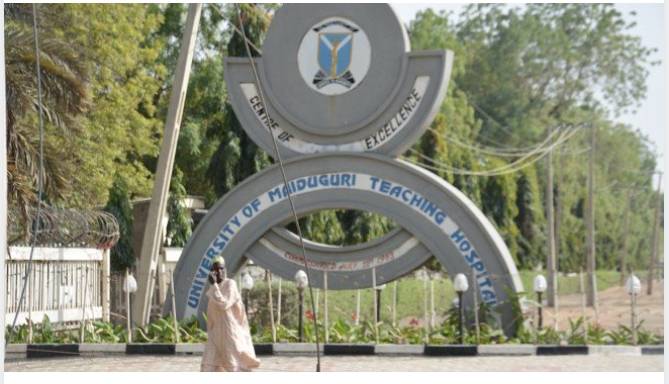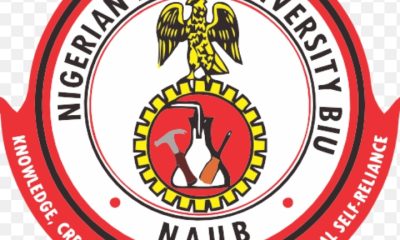Columns
The Craze for Easy Money in Nigeria and The Hanifa Story By Prof. M K Othman

The Craze for Easy Money in Nigeria and The Hanifa Story, By Prof. M K Othman
It was like a tale, told by a joker to spice an enjoyable gist but turned out to be unspoken truth. This is a story of a rural community located in an accident-prone busy highway, which links two capital cities of prominent states in Nigeria.
The accident-prone spot is nicknamed “Kwanar Mutuwa” because of the high frequency of road mishaps with astronomical fatalities and injuries. When such accidents occur, residents of the community rush to the spot under the pretense of aiding and rescuing the victims but end up stealing the properties (cash, phones, etc) of the victims.
In this very community, a resident could borrow money with a promise of repayment after robbing the next accident victim. Unfortunately, this dastardly act is fast becoming a norm in most accident scenes when victims who cry for help are being robbed.
These criminally-minded elements of society have gone to the extent of setting traps to punch/burst the tires of motorists on the highway to rob them when such motorists unsuspectingly stopped to find what is amiss.
This practice is common on almost every major highway in Nigeria. One of the most potent pieces of advice to drivers of today is “do not stop on a highway, no matter what happens with your vehicle until you reach a destination safe enough to stop”. All these things are done to make “easy money” or “get rich quick” without working for it. How did society reach this lowest ebb decadence?
Over ten years ago, kidnapping in Nigeria was just a story in the “action” movie and a few isolated cases in the Niger Delta. When President Umaru Musa Yaradua, granted amnesty to the restive youth of the Niger Delta, we all went to sleep, thinking that kidnapping and similar violent crimes would become part of our ugly history.
However, as the amnesty was being granted with all the lucrative packages, the seed of Boko Haram in the North East germinated. We did not take it seriously, we thought BH could just be crushed as we did to a similar organization called “Maitatsine” in Kano in the early 1980s.
Then, cattle rustling emerged in 2014 or so as one of the violent crimes, we were so lackadaisically unconcerned and did almost nothing to stop it. Some thought aloud, how could a bulky body frame animal, called cow be stolen in multiples of 40 to 100 and moved from one location to another without a trace?
How could they be sold in an open market without being uncovered by our intelligence system? Some felt, it was a Fulani affair, and they should be left to sort themselves out? In that early stage, I was moved to tears when I paid a sympathy visit to the father of my friend whose 43 cows were rustled.
Then, the guard of the cows, a Fulani man with his family, vehemently protested and opposed the rustlers who became frustrated and vicious, after overpowering the elderly guard, he was asked to say his last prayers as they were to instantly execute him before his wives and children. The execution was precisely what they did, left with cows and it was the last thing without a trace. Seeing the sadness, sorrow, and melancholy on the faces of those orphans and widows, I couldn’t resist shading drops.
Today, cattle rustling has transposed into full swing kidnapping and kidnapping of victims on transit has been incubated to poaching people from their residence. Time and places are no longer barriers for kidnapping as the incidence can happen anytime and anywhere with impunity without qualms.
No place or time is safe; one has to be prayerful at all times. Kidnapping is an organized, sophisticated, and all-inclusive crime, which includes cash exchange between the victims’ families and the kidnappers. Can’t it be nipped in the bud? Is it a failure of the intelligence system or operating system or both? Corruption and craze for easy money are the motivational factors nourishing and flourishing this crime. Some people lost their lives and many others sold out their capital assets to regain their freedom.
It is under this circumstance, the Hanifa episode hit the central nerve of society. There were spontaneous outcries from all angles as the Hanifa with her pretty innocent face, was not only heart-rending but could touch even the stonehearted people in the society.
Hanifa was a 5-year old pupil of Nobel Kids School, Dakata quarters, Kano state. She was chillingly murdered in cold blood and her body was shredded to pieces and buried in a shallow grave. The callous murder, cutting to pieces, and burial of the body parts were all perpetrated by the proprietor of Hanifa’s primary school.
READ ALSO: Maiduguri Law School: The Senate Approval And Senator Kashim Shettima’s Voice
The main motivator of this dastardly act of murder of an innocent child was to make easy money. We were all shocked, as no one could believe that this kind of atrocity actually took place in Nigeria. A school proprietor entrusted with 100s of children for imparting knowledge, good upbringing, and modeling for a brighter future; became a callous, cold-blooded murderer of one of the children under his care.
What a calamitous tragedy!
Hanifa’s case is not a common one but it is also not an isolated case as there are few other Hanifas murdered by their supposed protectors such as guardians and trusted neighbors.
In the last five months, bad news children killed in schools or kidnapped and killed have been devastating. The story of Sylvester Oromoni from Dowen School Lagos is similar to that of Hanifa. A petition from Oromoni’s family with 65 signatures reads “On Tuesday 30/11/2021, we lost our brother, 12 years old Sylvester Oromoni Jnr.
He was taken from us in the most gruesome of manner beaten by five senior boys in his hostel in Dowen College, Lekki, Lagos state. The students are from influential families and the school is trying to bury the case”. Another case was that of Asma’u Shuaibu Wa’alamu, an 8-year-old girl, allegedly abducted and killed by neighbor of the family in Zaria, Kaduna State, despite payment of N3m as ransom. Why are we crazy for easy money? Does money solve our problems or bring happiness to our lives? To be concluded next week
Columns
Medical and Health Developments Amidst Insecurity: The Case of University of Maiduguri Teaching Hospital (UMTH)

Medical and Health Developments Amidst Insecurity: The Case of University of Maiduguri Teaching Hospital (UMTH)
By: Balami Lazarus
Insecurity challenges have pervaded and taken over every inch of the Nigerian estate, spreading their wings, casting dark shadows stealthily in silence of ambush. The predator has created excuses against growth, progress, and development among ministries, departments, and agencies (MIDA’s), including health institutions where medical and healthcare services are needed.
Development means a different thing to many people. “An improvement in people’s living conditions inevitably contributes to higher productivity and to economic growth, subsequently development.” Therefore the needs of people in a particular area are their development. For example, health.
Moreover, development is essentially concerned with continuous improvements of the human life and condition right from time, in its capacity for qualitative and quantitative reproduction and capabilities to control and manipulate the environment for the betterment of mankind as a whole. Therefore, the purpose of development is to create an enabling environment for people to enjoy long, healthy, and creative lives at all levels of their growth and progress.
But for UMTH under Prof. Ahmed Ahidjo, the CMD, medical and health development in infrastructure, human capital, and healthcare services is a continuous process amidst insecurity in Borno State and Maiduguri, the state capital.
At UMTH, the story of growth and development has brought progress in health and medical services that are expected from institutional hospitals. The rate and level of medical and healthcare services through specialized medical centers equipped with modern state-of-the-art equipment second to none in Nigeria is a testament to health/medical development in the aforesaid hospital.
People have always examined the concept of growth and development from economic perspectives, refusing to align them to the objectives of human needs that will increase productivity to provide and satisfy these human needs to ensure good medical and healthcare service delivery that is available at all times in UMTH “Centre of Excellence.”
Prof. Ahidjo has no doubt facilitated the concept of health development through changes in the health and medical services provided by UMTH in spite of the ten security challenges staring us hard in the face.
Growth, progress, and development initiated by Prof. Ahmed Ahidjo is itself a concept of development in the health sector. The CMD has blended the concepts of development together through their aims and objectives, which are charted towards the improvements of the human standard of living in healthcare and medical services.
Prof. Ahmed’s efforts have therefore brought developments in the life of the hospital that have never been witnessed since the inception of UMTH, until the man with the Midas touch came on board with improvements and transformations of infrastructures and facilities.
Prof. Ahidjo had directed his development towards the satisfaction of the hospital’s needs, the primary objectives of UMTH, which translates to human capital development through teaching, practicals, medical research, and provisions of healthcare services to her immediate host community.
Therefore, development cannot be seen purely as economic, social, and political affairs but rather as an outcome of man’s effort to transform societal structures and institutions in the case of UMTH.
Balami, a Publisher/Columnist 08036779290
Medical and Health Developments Amidst Insecurity: The Case of University of Maiduguri Teaching Hospital (UMTH)
Columns
In Search of Our History Through Reconstruction and Restructuring of the Nigerian State for Peaceful Coexistence and Good Governance

In Search of Our History Through Reconstruction and Restructuring of the Nigerian State for Peaceful Coexistence and Good Governance
By: Balami Lazarus
This piece is an extraction from a paper I wrote years back intended to be presented to my society—the Borno Museum Society (BSM)—but it never saw the light of day. However, this is not the original title; I did some changes, putting in some terms to reflect the contemporary issues facing us currently as Nigerians.
Looking at the paper today, which had lain fallow since 1991, I laughed. Dr. Musa Hambolu and Mr. Kyari Bukar, as members, encouraged and urged me to make an effort and present the paper for onward publication in our newsletter, but it never happened. I believe this version will make sense to many more who believe in the Nigerian project as a sovereign nation.
And back to the main menu of the discourse.
One of the major historical developments in Africa south of the Sahara was the great Bantu migration that took place thousands of years ago. It was a mass exodus of the Bantu people, culture, and traditions; its droplets along the line of their migration gave birth to settlements, which had affected many ethnic nations’ language, culture, and traditions. What happened later is part of African history. We are now nestled between who are we? And what are we?
It is very clear that the reconstruction of our history through the restructuring of Nigeria and its state and conditions has long been toyed with, knowing fully well that it is the heart of our peaceful coexistence and good governance. It’s also the main bowl of our socio-political and economic growth and developments.
Our history, geography, and ethnology have drawn our attention to the state of sovereignty known, called, and addressed as Nigeria, a colonial creation, forgetting that we were here before.
the white man’s creation.
To trace the origin of the people that made up Nigeria, one cannot dismiss the substance of other disciplines like history, archeology, anthropology, geography, sociology, and linguistics, and other related subjects. These fields of scholarships have tremendously improved in the explanations of our history, artifacts, and cultural source materials of the people that were wrongfully and forcefully brought together to live and form Nigeria. Therefore,
There is the need for the restructuring of the Nigerian state for peace and good governance for the benefit of all citizens.
To achieve this, we must collectively agree with one voice to restructure our systems to find a lasting solution to our torn political garment, unity shredded with suspicion generated by us over the years. Because modernization is the process of change towards social, economic, and political systems.
Historically, Nigeria is a conglomerate of large ethnic diversities, and each represents a distinct nation with different cultures, traditions, and civilizations living independently before the forceful amalgamation of 1st January, 1914, carried out and executed by the British colonial masters. Sources available to political historians on our past underscored the necessity to shift from the present state of nationhood to a common ground that will provide us with equal opportunities to maintain and sustain our togetherness as one indivisible and indissoluble nation through reconstruction and restructuring.
The reconstruction and restructuring of our historical and political past is paramount; it will aid in checking the high rate of insecurity and criminal activities of bandits and kidnappers. And shall also clamp down on terrorists and the rise of insurgents. Restructuring will reduce sentiments and segregation in the activities of our national life.
History does not repeat itself. But people repeat history and then falsely accuse history of repeating itself.
We have consciously decided to polarize our country with Black Strike sentiments. And here we are, with agitations in different forms: Oduduwa, Biafra, Middle Belt, and Niger Delta.
Balami, Publisher/Columnist 08036779290
In Search of Our History Through Reconstruction and Restructuring of the Nigerian State for Peaceful Coexistence and Good Governance
Columns
Aspirations: A Compass for a Purposeful Journey of Life

Aspirations: A Compass for a Purposeful Journey of Life
By: Harmony Shimbura
A blueprint for a purposeful journey, the human experience is often defined not by where we are looking, but by having aspirations, a compass of purposeful life, and an act of claiming agency over one’s future.
My life’s aspirations are not merely a list of goals or a collection of ‘bucket list’ items. It is a living philosophy, a commitment to growth, connection, and the relentless pursuit of a life lived with intention. They are threads woven together for personal values and to give back to your community.
I believed the core of aspirations should be a desire for perpetual evolution. And I also believe that the moment we stop learning is the moment we stop breathing. Therefore, one of my primary goals is to remain a lifelong student where learning is a continuous process.
I aspire to deepen my understanding of the world through diverse perspectives, whether it is through traveling to places where knowledge is obtained by listening or observations, as is the case with the traditional Cherokee ways of learning.
I constantly challenge my own biases, spiritually and mentally. I aspire to reach the state of equilibrium where my peace is not dependent on external circumstances.
Do you know that aspirations transcend titles and salary brackets? Moreover, my true ambition is practical impact. I want to be engaged in work that I feel is the extension of my soul in it at whichever level. I also
I believe that work should be a contribution to the collective good of humanity.
As a young lady, I am on the self-push to achieve a level of mastery in my chosen field where my intuition is as sharp as my skills. I want to be known not just for what I did, but for how I did it with integrity, excellence, and a collaborative spirit.
Most of us neglect the vessel that carries us through life, but I aspire to treat my body with the respect it deserves. My aspirations for health are not about vanity but for sanity in purity.
These aspirations are not a destination I will one day reach; they are the fuel for a lifelong journey.
Harmony Shimbura writes from Zaria. 07033886918
Aspirations: A Compass for a Purposeful Journey of Life
-

 News2 years ago
News2 years agoRoger Federer’s Shock as DNA Results Reveal Myla and Charlene Are Not His Biological Children
-

 Opinions4 years ago
Opinions4 years agoTHE PLIGHT OF FARIDA
-

 News9 months ago
News9 months agoFAILED COUP IN BURKINA FASO: HOW TRAORÉ NARROWLY ESCAPED ASSASSINATION PLOT AMID FOREIGN INTERFERENCE CLAIMS
-

 Opinions4 years ago
Opinions4 years agoPOLICE CHARGE ROOMS, A MINTING PRESS
-

 News2 years ago
News2 years agoEYN: Rev. Billi, Distortion of History, and The Living Tamarind Tree
-

 ACADEMICS2 years ago
ACADEMICS2 years agoA History of Biu” (2015) and The Lingering Bura-Pabir Question (1)
-

 Columns2 years ago
Columns2 years agoArmy University Biu: There is certain interest, but certainly not from Borno.
-

 Opinions2 years ago
Opinions2 years agoTinubu,Shettima: The epidemic of economic, insecurity in Nigeria








